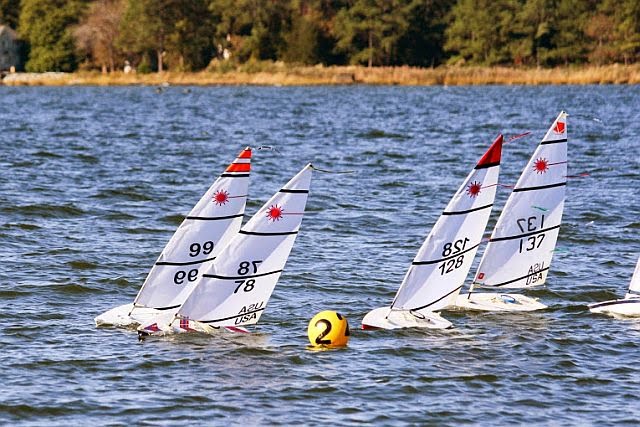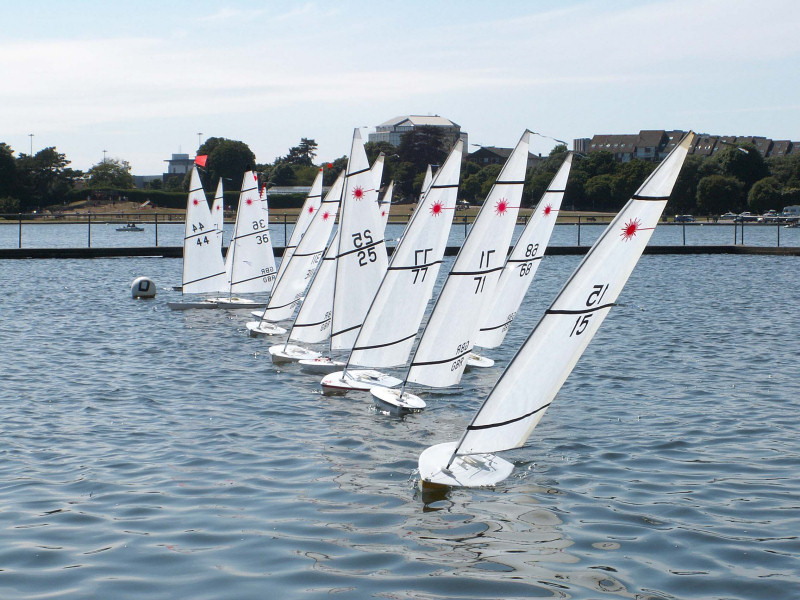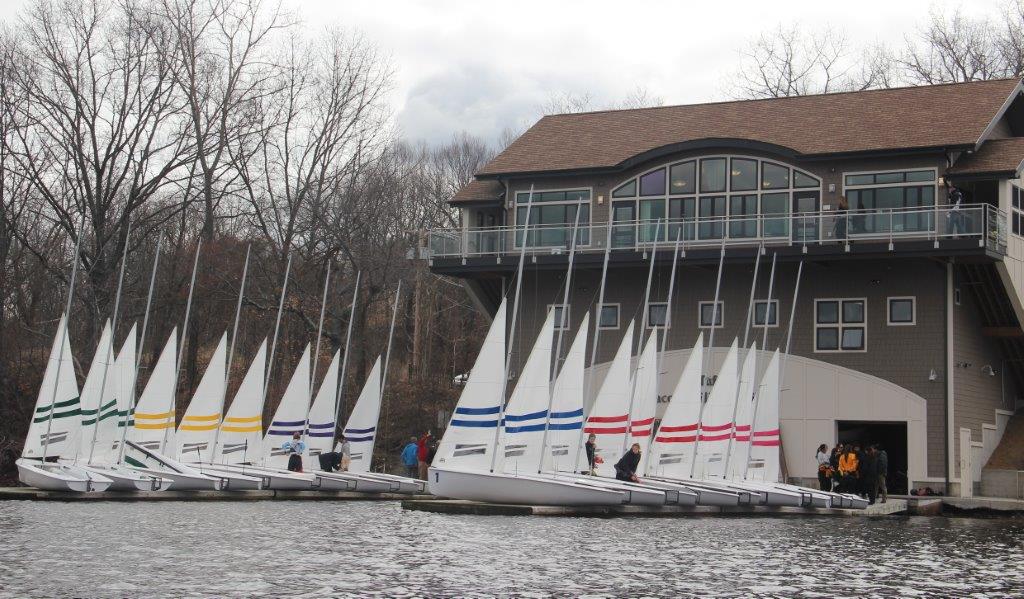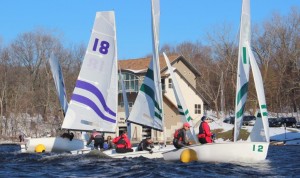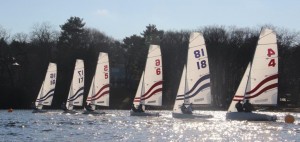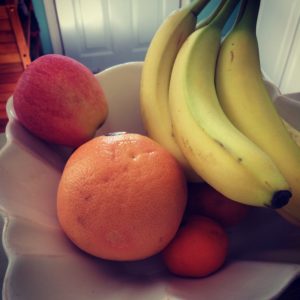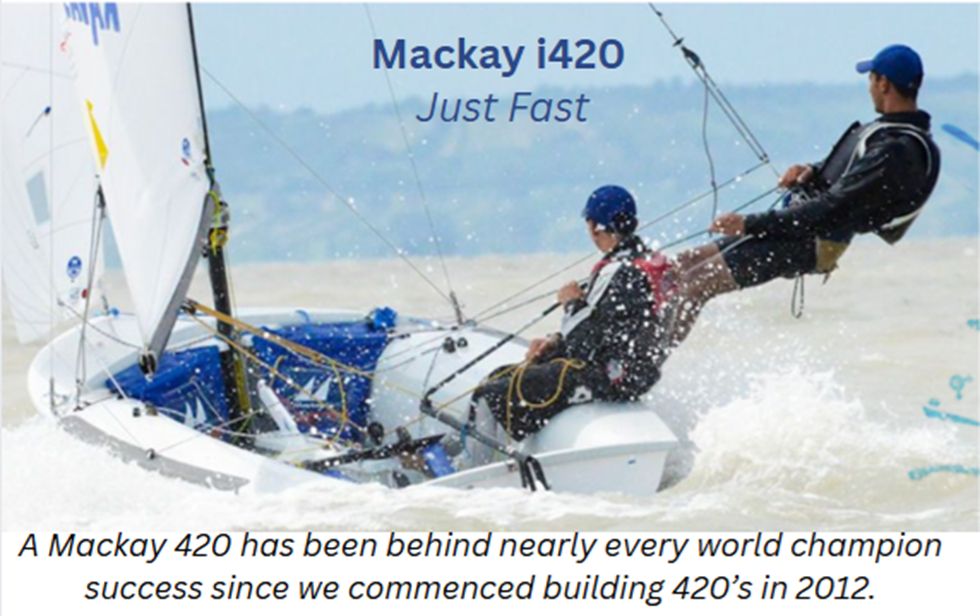Tred Avon YC Embraces RC Fleet into One Design Program
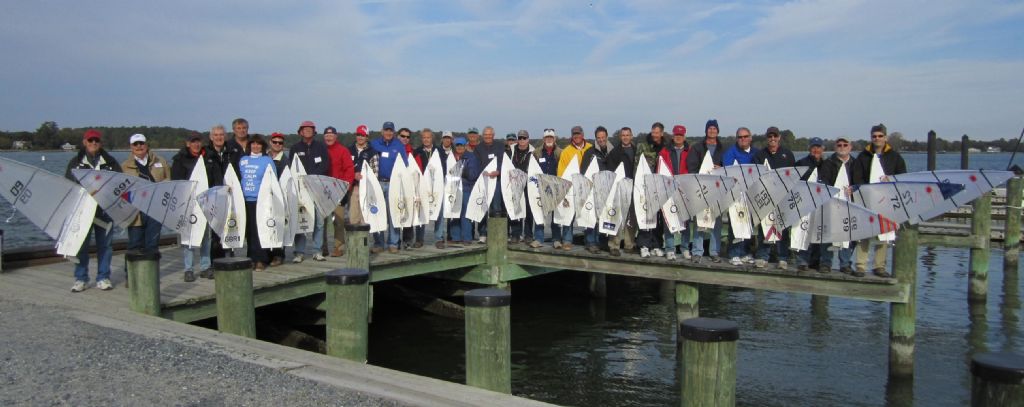
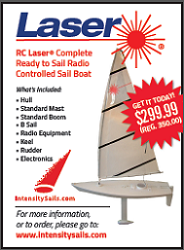
Along with other forward thinking yacht clubs like Larchmont and San Diego, Tred Avon Y.C. is in the vanguard of including radio-controlled sailing within established racing programs. Prior to officially sanctioning the Oxford RC Laser fleet, over the last several years Tred Avon Y.C. has hosted several major RC championships, and already enjoys considerable recognition throughout the USA as a leading RC venue. In late October, TAYC will host the National Championships of the EC12, 5′ scale model based on America’s Cup yachts of the 1970’s. EC12 is one of the largest and most popular classes in AMYA.
The Oxford RC Laser Fleet predominantly sails RC Lasers, 1/4-scale replicas of the popular Olympic dinghy, but several members race other RC classes as well. The Oxford fleet sails late Wednesday afternoons in the spring and fall. Orientation sessions for those interested are held Wednesday afternoons prior to racing. Tred Avon Y.C. encourages both members and non-members to give remote controlled racing a try (the club collects a nominal fee from those participating as non-TAYC club members).
Remote Control sailing at Tred Avon YC is led by Dave Branning as the RC Fleet Liaison. Branning reports to TAYC Board Member, Brandon Loveless, who leads the centerboard and one-design classes at TAYC. Oxford RC Laser Fleet Captain, Bob Roe, has an active racing season planned for 2016 that begins on March 16th.
For more info, contact liaison [email protected]
Interested in an RC Laser? Check out S1D Team Member Intensity Sails. They can set you up!
Club Profile: Sail Newport Expands!
Sail Newport expands its footprint to keep up with demand.

Sail Newport is THE premier community sailing center in Rhode Island and highly regarded across the country. This profile and a tremendously skilled staff and cadre of volunteers available for sailing adventures have made Sail Newport one of the Go To venues for hosting your regatta. They can and have run regattas as diverse as a local Opti Green fleet event to regional, national, North American and world championships plus elite events: the VOR and America’s Cup world series. For example, on the Sail Newport calendar for 2016, beginning end of April running thru to end of October there are Four National championships, two North Americans, a couple of regionals, several youth related coaching and Opti like regattas, the Melges 32 worlds and the World Match Racing tour Newport stop. With the ‘other’ regattas, Sail Newport is hosting a total of 24 regattas in 6 months…..And that is just ONE entity in Newport…
But after close to thirty-three years, Sail Newport has outgrown is the physical plant at Fort Adams. The buildings are both small and aging and becoming vastly outgrown by the continued growth of Sail Newport and related growth of staff amongst other elements.
In order to meet this pre middle age spread as it were, Sail Newport’s board, directors and executive staff, led by Executive Director Brad Read, have been developing a plan for modest expansion to accommodate the increasing demand for the services that Sail Newport’s core mission offers. The centerpiece of this expansion is the construction of a building on land that regulars will commonly see rigged with a tent in summer, at the foot of the Admirals pier.

Embracing Rhode Island’s commitment to a more environmentally and sustainable future, the building will encompass many of the latest environmental building practices: Solar panels, landscaping and filters to mitigate the effects of water run off and many related elements of contemporary ‘green’ building. And because of the historical aspect of the Ft. Adams complex the new building is designed to compliment the look of existing buildings on the property.
On a dark and stormy April night in Newport, RI, the feel was a lot more summer, kids, sailing and learning, inside a meeting room at the Newport Public Library. This was the venue for the Environmental Assessment /Assessment of Effect open house required by law. A gathering of twenty five to thirty people some dripping from the torrential rain outside milled around reading the overall brief, studying renderings of the building, plans for the project and discussing the project. Because Sail Newport leases it facility from the State of Rhode Island and the entire Fort Adams complex is under the control of a variety of federal agencies, there were representatives from these agencies to answer questions. Read and senior staff from Sail Newport were present as was Mohamad Farzan, principal of Newport Architecture, the designers of the building. Other stake holders in the Park including the president of Newport Rugby a perennial consumer of the fields up the hill to the west of the Ft. Adams access road were seen browsing the presentation.
Sail Newport is indeed a fantastic facility for sailing from, especially in the summer. The introduction of this new building is very timely considering the expansion of, in particular, High School sailing in the spring. Apart from the small Sail Newport office the other buildings available are unheated and so not conducive to chalk-talk like activities when the in the water conditions do not lend themselves to sailing.
Beginning this spring, three of the high schools on Aquidneck Island plus Prout School in Wakefield RI are all sailing out of Sail Newport and this is creating it’s own great Gravitational Density for local youth sailors. On a recent Wednesday afternoon sailing from Sail Newport were the four schools mentioned plus St Georges sailing a match against Moses Brown plus a couple of the St. Georges JV teams practicing. All told there were close to twenty five 420’s out sailing with perhaps 60 teenage sailors on the water, 6 coach boats and several racing and practice areas going all at once. And this count excludes Salve Regina University who is based out of the boat basin at the north end of the park. If they were out too, the count may well be over 40 boats and a hundred young sailors.
That Newport is the Sailing Capital of the world there can be no doubt. The new building on site and the expansion of the Sail Newport core mission, to introduce youth sailors to the sport and to provide public access to the water will add another boat length or two to this truism and make Sail Newport an even better place to sail from than it already is.
A Look at Forestay Sag
By Andrew Kerr
A key element of upwind performance is forestay sag – how loose the forestay (or head stay on a masthead rig) is for the given set of wind and sea conditions.
The setup is crucial to boat speed and pointing as it sets up the entry and power of the headsail as well as the effectiveness of both sails as one combined foil.
Why forestay sag is fast in light air and then slow when overpowered:
Forestay sag is fast in light air as it opens up the luff of the sail to the wind, powers up the Jib and in effect moves the sheeting angle inboard as the leech profile of the sail moves in as the luff of the sail moves out.
In effect it is like” in hauling” the Jib or putting a set of sheeting tracks inboard; the net of this is more power and higher pointing.
The draft of the sail moves forward and to leeward and it helps the sail to respond more dynamically in light air to puffs and lulls.
Where diminishing returns set in with forestay sag is when the boat starts to become overpowered , the headsail gets too deep and round , causing too much leeway and the mainsail to backwind too much , it becomes a net loss in both speed and pointing and it is time to take the sag out.

The upper shrouds on aft swept spreaders – the tighter the upper shrouds the tighter the forestay, but this is not the case with in line spreaders where the uppers do not control forestay sag.
Lower shroud tension – lower shroud tension helps keep the lower part of the mast in column so that when backstay is applied it can go more directly to forestay tension.
The length of the forestay – a longer forestay creates more sag, as the wind increases the forestay can be shortened to reduce sag.
Adjustable aft lowers (as on a Santana 20) – the more aft lower that is applied the tighter the forestay, we use the aft lowers in conjunction with the backstay to keep a good form shape in the Mainsail luff curve.
Backstay tension – pulling on the Backstay tightens the forestay and flattens the headsail.
Mainsheet tension – the tighter the mainsheet the more the mast bends, the less forestay sag.
Mast heel position – on boats like J24’s that have adjustable mast heels or chocks like on an Etchell’s. This controls Pre Bend in the mast or the “pre stress” of the mast to fit the luff curve of the mainsail.
As the heel comes aft the Mainsail becomes flatter and the top of the mast goes forward, increasing forestay sag. As the heel of the mast goes forward the pre bend is reduced, the Mainsail becomes fuller and the forestay tightens, flattening the headsail.
Running backstays that have termination points at the forestay – the tighter the runner, the less forestay sag for a flatter headsail.
How to measure and gauge forestay sag when sailing:
A good way to measure the sag is to go sailing and anchor a spare halyard down next to the tack of the headsail and tighten it as much as possible , then sight up the forestay and look at the distance between the firm halyard and where the biggest amount of sag is relative to that .
How can you tell the forestay is too loose when you are sailing?
One of the telltale signs is that the mainsail luffs early and often despite the fact the backstay is on tight.
When setting the boat up upwind we try to get the luff of the headsail and the luff of the Mainsail to break as closely together as possible, in this instance the Mainsail will luff earlier than the headsail.
The reason is primarily that one of the byproducts of the sag is the luff of the headsail opens up to the wind but the back of the sail – the leech profile, returns inboard which when in excess, can cause excessive backwind in the mainsail and the headsail to be too deep.
Typically when we see that we tension the backstay to reduce this, if this does not work then that is an indicator that the rig is too loose or the forestay is too long, or on some boats the mast heel is too far back (too much pre bend), these are common when sailing in light air and then the wind increases progressivley during the race.
Another indicator of too much forestay sag for the given backstay tension is over bend wrinkles in the mainsail – indicating that we are over bending the mainsail to the designed luff curve and also the given backstay application is not giving us the required forestay tension.
This typically indicates the rig is too loose, the forestay is too long or the mast heel is too far back with too much pre bend in the mast for the stronger wind.
How can you tell that the forestay is too tight when you are sailing?
In this instance the headsail will look too flat on the entry – despite easing the backstay.
The Headsail will also look too flat and the boat will feel very underpowered in the lulls with a very tight steering groove and the Genoa will tend to luff early relative to the mainsail.
This very often happens when the boat was set up with a tight rig or tight forestay for heavier air and then the wind has dropped.
How much forestay sag are we looking for?
This varies from class to class and it is best to consult your sail maker for exact numbers, but the principles that we are looking at apply.
Watch carefully how the Headsail and Mainsail luffs break, are they working fairly close together or is there a big gap in when they luff. Does the Headsail look too full and the boat feel overpowered or do we have a good steering groove?
As an example, in a boat like a J24 – 8 to 10 inches of sag is good for light air for lots of power, 4 to 6 inches in medium air to maintain good pointing and as little sag as possible in heavy air to keep the headsail flat and the sails working well together.
I remember coaching at a Heavy air J105 regatta in San Francisco, it was blowing 25 to 30 knots and in watching the boats go upwind you could tell by the rig set ups who the top boats were – the teams with the most rigid, tight forestays had flat Jibs and Mainsails that were driving.
Teams who had more forestay sag had fuller Jibs and the Mainsails were luffing early and often and they were not pointing as high or tracking as well.
What if my Boat does not have an adjustable Backstay has a roller furler and the spreaders are in line and not swept back?
In this instance we will have marks on the Forestay turnbuckle for light, medium and heavy air and adjust it at the dock prior to racing for the given days conditions.
Your sail maker will be able to recommend how loose to have the forestay in lighter air to help with sag for the sails design and then how tight to go as the wind increases.
Set the Boat up for the Lulls, not the Puffs.
When tuning the boat we look to set up for the lulls not the puffs , so if the wind is 8 to 12 knots , we set up for the 8 knots in the knowledge that in the puffs we can always depower with Steering, Hiking and if available – backstay tension .
But if the boat is set up for 12 knots, performance will suffer in the light spots as there will be little recourse to power up with.
In light air a good mantra is to “Be the first boat hiking” – in other words set the boat up for power so you have your crew hiking first versus other teams and having the correct amount of forestay sag will be a critical component of this.
The Lark Dinghy: A New Era Begins
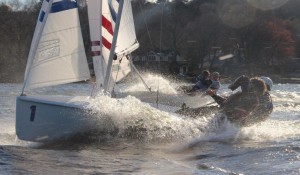
Hulls and decks were hand made with expert craftsman, are resin infused and bonded to a Soric core. The result is a lighter, stiffer, more consistent structure for simply a better boat. Doyle Sailmakers in Swampscott, MA also hand craft locally matching or even improving upon the long lasting sails they made back in 2010. The enormous “fat-head” mainsail powers up the boat as a spinnaker would downwind but twists off in big breeze upwind for any weight combination. The jibs were increased in area as well. Selden Spars of Charleston SC, provided tapered aluminum kappa section masts for power and weight saving along with ultra-light carbon booms.
Unique to college sailing features on these Turbo Larks include boom vang and Cunningham controls led back to both sides in between skipper and crew. Rudders are cassette style and centerboards are now composite, unlike the old plate aluminum boards of the past. The best feature of all might be the hull design which has passed the test of time since 1967. The deep “V” bow and narrow waterline allows for phenomenal light air upwind speed and feel. The flare to the rail puts hiking power where it belongs, outboard, allowing skipper and crew to keep far more power than they could on a narrower boat.
Tufts is home to some dozen college regatta per year and has been chosen host site for the 2017 Fowle Trophy Regatta for the New England Intercollegiate racing championship next April. This May some 48 alumni teams will take part in a massive Tufts Alumni regatta.
Club Profile: Boothbay Harbor Yacht Club
 Boothbay Harbor Yacht Club (BHYC) in mid-coast Maine has been celebrating yachting for over 100 years, welcoming boaters who want to experience the fabled Downeast cruising grounds and picturesque Boothbay Harbor. News Flash: BHYC is Hiring!!
Boothbay Harbor Yacht Club (BHYC) in mid-coast Maine has been celebrating yachting for over 100 years, welcoming boaters who want to experience the fabled Downeast cruising grounds and picturesque Boothbay Harbor. News Flash: BHYC is Hiring!!Our location on the water in West Boothbay Harbor offers a panoramic view of the harbor and the boats that utilize it. We have an extensive mooring field and offer full time tender service in the summer months. A large number of rental moorings are available to visiting yachtsmen and yachtswomen. We also offer a full service waterfront dining facility open for lunch and dinner with professional chef and staff.


 The club has an active Junior Program designed to introduce children to sailing, tennis and golf from age 4 (tennis), 5 (golf) or 8 (sailing) up through 17. The opportunity to develop either recreational or competitive skills while having fun has been a mainstay of the Junior Program since its beginning.
The club has an active Junior Program designed to introduce children to sailing, tennis and golf from age 4 (tennis), 5 (golf) or 8 (sailing) up through 17. The opportunity to develop either recreational or competitive skills while having fun has been a mainstay of the Junior Program since its beginning.News Flash: BHYC is Hiring!!
Boost Your Performance: 4 Simple Steps For Better Sailing Nutrition
By Airwaves writer Rachel Bennung
Ever heard the saying, “You are what you eat?” This saying is more true then most people realize. Everyday people are forgetting how essential nutrition is in not only sports performance, but your everyday living. You can be strong and fit, but if your nutrition isn’t in line your hurting your performance more then you realize. To perform at your best you need to have a healthy diet along with a training plan. In this article I will touch on ways you can boost your performance by eating a clean healthy diet.
Nutrition is a tricky thing for people to understand. Today we see marketing for food and beverages everywhere we go. We also hear everyone telling us different things about what is good for us and what is bad. This can become very confusing for any person! So what is the right thing to do? The four following steps are my simple ways to start eating right and boost your performance, and the way you feel on a daily basis.
- Get Back To The Basics
My first step to everyone is get back to basics. Nowadays processed food is everywhere and it’s hard to escape it. However, what are bodies really need are whole foods. For example instead of eating potato chips cook up a real potato, or instead of drinking juice have the real fruit. When you get back to the basic food groups you will see changes in your body. You will have more energy to get out sailing and perform at your best. By eating whole foods you will provide your body with the nutrients it needs, where processed foods provide little value to your body. To last longer on the water we need to be providing our bodies with all the nutrients it needs. Start this transition by replacing some of your typical food choices with whole foods.
- Hydrate

- Find What Works For You
Something we all need to remember is every body is different, what works for you may not work for another person. Finding what works for your body will make your feel great and enhance your performance. This is essential to your success for performing better both on and off the water. For example some sailors need to eat a full lunch on the water while sailing, however, then we have some sailors who rather eat something small like a granola bar to keep going. You need to find what works for your body. Different foods may also not agree with you, so you need to make a note and try to avoid them in the future. Your diet is a learning process, and you need to make it work for you. To better your performance on the water we want to find foods that make us feel great and give us energy throughout the day!
- Make It Fun
Your daily diet can sometimes feel very hard to deal with everyday. However, you can make it fun! Find ways to make what your eating not a chore, but a fun process. In the mornings you can start your day off with a smoothie adding all different fruits and vegetables. Instead of buying granola bars that are packed with so many calories and sugar, experiment with making your own (check out my easy recipe down below that you can make at home). Make water more fun and easier to drink by adding some lemons and mint. There are so many ways to make your diet fun and all the while helping yourself in your daily life and your performance. Check out below fun healthy snacks that are great for sailors.
Fun Snacks:
-Apple chips
-Homemade granola bars
-Homemade trail mix
-Peanut butter or almond butter with fruit or vegetables
-Homemade smoothies
-Hardboiled eggs
-Kale chips
Homemade Granola Bars
- 1 cup Pitted Dates
- 1/4 cup Honey or Maple Syrup
- 1/2 cup Almonds
- 2 cups Rolled Oats
- 1/4 cup Pumpkin Seeds
- 1/2 cup Buckwheat
- 1/4 cup Shredded Coconut
- 1/4 cup Coconut Oil Melted
- 1/2 cup Rasins
- Microwave dates with a little bit of water in the bowl. Process dates in a food processor until forms a dough like consistency.
- Mix together oats, pumpkin seeds, buckwheat, raisins, shredded coconut, and almonds.
- Add to mixture coconut oil, dates, and honey.
- Mix all together then spread in pan flattening out the mixture.
- Bake for 20 minutes at 275 degrees.
- Let cool then cut the bars.
- Store in freezer until ready to enjoy.
As sailors we spend a lot of time training on land and on the water. However, when it comes to our nutrition we are usually falling short. We need to eat to enhance our performance for both on and off the water. What we put into our bodies effects our everyday life and performance more then we think. Once you start eating right for your body you will see a major improvement in the way you feel, and in your performance. Going back to the basics, hydrating, finding what works for you, and making it fun will help you on your way to becoming a healthier stronger sailor.
For more information on fitness and nutrition for sailing contact [email protected]. Also check out Sailorcise on Facebook, Twitter, and Instagram for daily tips on fitness, nutrition, and sailing.
Club Profile: Vero Beach Youth Sailing Foundation
.….The Kids Build The Boats..The Boats Build The Kids….
|
Youth Sailing Foundation of Indian River County, Inc. is a 501(c)(3) organization funded solely by donations and local grants. Our free sailing lessons are open to Indian River County children, age 9 to 18, who can pass a swimming test. High school students are invited to participate in our free Vero Beach High School or Indian River Charter High School Sailing Teams. YSF also offers adult sailing lessons for a fee. |
|
Why sailing? In learning to sail, children learn life skills that will guide them their entire lives. Our program takes children outdoors, away from computers and cell phones while providing vigorous physical activity. Our children learn to rig and pilot their own sailboat, complete races, understand the sailing language, and interact not only with children but with adults. YSF’s success is measured in the self-confidence, discipline, decision making, and leadership skills that become evident in our students. Our progress and growth since our 2009 beginning is the result of the generosity of the community in both monetary gifts and volunteer hours. Partnerships with the Vero Beach City Marina, the Vero Beach Power Squadron, and the Moorings Yacht Club have given us the impetus to expand and create the type of programs we desire to offer to the community. We have built a total of 33 wooden Optimist sailboats, 24 of which were donated to be used by children who cannot sailboats. The Vero Beach High School Sailing Club uses our twenty Club 420 two-person sailboats. We own 5 twelve-foot Trinka sailboats and 4 nineteen-foot O’Day Mariner sailboats which are used both for the adult and the children’s classes. We also have numerous power boats that are used as safety boats while the students are sailing. Our program has many facets: 1. Free childrens beginning sailing instruction by certified US Sailing Instructors under the direction of our Sailing Director. Both classroom and on the water training is provided on Saturdays during the school year. Eight-foot long Optimist sailboats are used for beginning sailors between the ages of 9 & 14. Our beginning sailors sail on Saturday mornings and our more advanced sailors sail on Saturday afternoons. 2. In September of 2014 Youth Sailing Foundation collaborated with Vero Beach High School to form a high school sailing team using our Club 420 two-person sailboats. These boats are used nationally in high school and collegiate competition. In February 2015 the Vero Beach High School Sailing Team competed in a sanctioned ISSA (Interscholastic Sailing Association) regional regatta and as a result, 8 team members received Vero Beach High School Varsity letters. In September of 2015 Indian River Charter High School was invited to participate by creating the the Indian River Charter High School Sailing Team. The high school team practices on Wednesdays and Fridays after school. Our goal is to expand this program to include all Indian River County high schools. 3. In the spring of 2014 Youth Sailing Foundation started an Adult Sailing program. Adults pay $400.00 for eight 3-hour beginning sailing lessons combining on-the-water and classroom training. The adult students sail YSF’s 12-foot long Trinka sailboats and the ratio of students to instructors was very low. We now offer beginning and intermediate sailing to Adults. Classes are on Thursdays and Saturdays. The tuition collected from Adult Sailing is being used to fund our free children’s sailing lessons. 4. YSF’s Summer Sailing Camp is held at the Moorings Yacht & Country Club each summer. In 2015 YSF expanded from 6 to 8 one-week long beginning sailing camps for children between the ages of 8 and 13. Camp hours are 9 AM to 3 PM Monday through Friday. Children learn to sail 8-foot long Optimist sailboats. The fee to participate in one week of camp is $250.00 which includes lunch each day. 5. For those who like wood working, YSF offers the opportunity to assemble an eight foot wooden Optimist sailboat from a kit. Parents and children are closely supervised and assisted by trained YSF volunteers. The kit costs $2000. It takes approximately 40 hours to assemble the Optimist sailboat. |
Profiles in Amateur Sailing: Jimmy Gieseke

Newport, being the sailing capital of the world that it is, has a full compliment of local sailors including a large cohort of high school and college sailors. Jimmy Gieseke is a sophomore at URI. I first met him and his twin Johnny as freshman at the Prout High school when they joined the sailing team. I had a chat with Jimmy on a cold blustery day in Newport in January—
S1D: Jimmy, giday mate, thanks for coming out. Just paint me a quick picture of YOU, are you a local?
JG: Yes I was born in Providence and lived in Newport all my life.
S1D: What was your first introduction to sailing?
JG: Our dad had sailed as a kid and growing up and we would rent the Rhodes 19’s at the Navy base when I was little and it just went on from there. We got put into the Sail Newport Opti program as soon as we were old enough, 6 or 7 and it went on from there.
S1D: Were you and Johnny in the same boat?
JG: No, we were in the same classes but Sail Newport’s policy is one sailor per Opti, so if your are going to learn to sail, they say, you’re going on your own. So I did Opti’s all the way thru, the whole deal. But I was not really, ya know into sailing or got interested in competitive sailing until up until my Sophomore year in high school, when I went to Rodgers (high school in Newport) and started team racing.
S1D: What is it about sailing that gets you jazzed?
JG: It’s always different. You go out there and its going to be a light day, windy day, shifty anything, it is never the same.
S1D: Do you, have you, done much sailing WITH Johnny?
JG: Well in the Opti’s we were in the same class but in our own boats. We are different kids of sailors, I like, kinda taking charge, steering and Johnny likes to pull ropes.
S1D: So you steer and Johnny does the mast?
JG: (laughs), yeah, that’s it. No, no, he knows what he is doing, but we are just different types of sailors, I can’t really explain it.
S1D: What is the most fun about going sailing, then what is the least fun?
JG: Getting hyped up with friends, you know, just having fun with my friends. I have never been much of a solo sailor you know the kind of person who likes to go out sailing by my self. I like to have someone to share the experience with. Say like the Ida (Lewis Yacht Club Distance) race, having a group of kids all my age to get on a J111 and go out and kick butt and have a great time with my friends is very special. Yeah and it is really great for Fred (Van Liew part owner of the J-111 Odyssey) to let us use boat and go race it, amazing.
S1D: Would he be active in the operation of the boat, or do some coaching or…?
JG: He will do some coaching Mostly he will just sit and let us go, he will take charge if he feels it is necessary…
S1D: Stopping you doing something too dopey…?
JG: Yeah…laughs
S1D: ok and the worst part?
JG: Ah, doing something that’s not fun…
S1D: Are you ok when it’s blowing like stink?
JG: Oh yeah, that is really fun too, pushing the boat, what ever the boat I am sailing, pushing myself hard too, that is really fun, but ah, working on boats, you know fixing them, that is the least fun part, which is kinds funny with our 49’r. You heard about that?
S1D: No
JG: Ah, well we got a free 49’r hull and mast from a friend who was trying to get rid of it
S1D: (laughs) what could go wrong…
JG: yeah what could…The hull had no gelcoat, they had taken a sander to the hull down to the glass, the deck was coming apart, it was a wreck, total garbage. So we went on Craig’s list, found a guy with a 49’r whose boat had capsized in the parking lot in a blow, and smashed up the rig, but the hull was fine so we bought that hull and put the other boats mast in it, and then it has been nothing but problems….Chuckles
JG: So we have had a time figuring out things, you know the mechanics, like standing rigging, the info we got on the lengths was wrong- we found out after we had them made up…so the D1’s have two turnbuckles on them coz the wire was too short, stuff like that. So we can sail it but it is a hand full and we don’t really know what we are doing.
S1D: can you elaborate in that? In the scheme of high school sailors, you two are pretty good and have a wide swath of experiences…
JG: well not so much not knowing what we are doing, but the idea of twin traps, steering from the trap, the 75 things that have to happen, so its pretty physically demanding, you know and in what sequence and what happens if you get out of sequence, it is pretty tricky that way, and it is not really set up properly. And there are a million tweaky things, rake, bend, pre-bend that are not on a 420, a club 420 or even an I-420 has only half a dozen strings and that’s it.
S1D: Have you sailed other sporty boats, a 505 say or something between a 420 and a 49’r?
JG: No, I have not sailed a 505, nothing like that but we have sailed cats some, the –F 16’s some.
S1D: How was that?
JG: Oh that was fun, cats are cool boats.
S1D: So how was that, technically, going fast, but kind of upright, how did it feel, what is your sense of the cat versus the 49’r feel wise?
JG: Quite different, it is a whole different feel to the Cat. They go so fast with relatively little effort, they are just kinda go with the flow and are usually pretty flat where as on the 49’r we spend a lot of time just trying to keep it upright, steering around waves, more demanding steering wise, let alone going fast.
Club Profile: Little Washington Sailing School

News Flash: Little Washington Sailing School is Hiring! 2 open positions!!
LWSS was founded by sailing enthusiasts to teach kids sailing and appreciate Washington’s marine assets. The club started with a fleet of 14 ft Vanguard 420’s; in 2015 LWSS added 8 ft Opti’s, used world-wide for junior training. The program promotes self-reliance, awareness of safety, sportsmanship, teamwork, self-confidence and respect for others. The curriculum introduces seamanship and the fundamentals of sailing for beginners; a week of advanced sailing is taught at season’s end. The U.S. Sailing Curriculum is used and our instructors are certified by U.S. Sailing.

News Flash: Little Washington Sailing School is Hiring! 2 open positions!!
S1D ICSA Team Race Rankings, 24 March 2016
March 24, 2016 – Sponsored by Dynamic Dollies, this is the second installment of the 2016 ICSA Team Race Rankings. Panelists include Ken Legler (Tufts University), Ward Cromwell (College of Charleston), Clinton Hayes (Stanford), and Johnny Norfleet (Fordham) and Bill Healy (Yale).
2016 i420 Midwinter Championship Results
2016 International 420 Mid-Winter Championship
|
|
International 420 (27 boats) (top)
Series Standing – 9 races scored
Information is provisional and subject to modification
Regatta results last updated: Sunday, March 06, 2016 1:14:32 PM CDT
Click on race number to view detailed race information.
Pos,Sail, Skipper, Yacht Club, Results, Total Points
1. 55162, Wiley Rogers/Jack Parkin, TCYC/LYC, 1-5-6-6-1-7-4-[14]-1- ; 31
2. 55172, Payton THOMPSON/Victoria Thompson, NHYC/LISOT, [10]-3-1-7-2-5-5-5-5- ; 33
3. 55116, Alex Abate/Marcus Abate, Lakewood Yacht Club, [18]-2-4-1-4-2-10-2-10- ; 35
4. 55917, Dylan Ascencios/Hunter Skinner, Lakewood Yacht Club/ LISOT, 2-6-7-11-8-1-6-3-[28/DNF]- ; 44
5. 55876, Carmen Cowles/Emma Cowles, Larchmont Yacht Club/LISOT, 6-9-9-2-[10]-4-1-10-7- ; 48
6. 55621/55617, Eduardo Mintzias/Katherine Lounsbury, CRYC/LIMA, 3-4-11-5-6-9-2-[28/DNS]-17- ; 57
7. 55570, Emma Kaneti/Catherine Beatrix E. Lindsay, Larchmont Yacht Club, 8-1-5-8-13-8-15-[21]-15- ; 73
8. 55873, Kathryn Hall/Ashton Borcherding, LISOT, 9-15-2-13-18-15-[21]-4-3- ; 79T
9. 55617/55146, Joseph Charles Hermus/Reese Guerriero, Bellport, 12-7-3-10-16-[18]-9-8-14- ; 79T
10. 53629, Timothy DANILEK/Pierce Ornstein, Noroton YC / LISOT, 16-11-10-3-3-13-[18]-15-9- ; 80
11. 55494, Anna-Luisa Brakman/Grace Austin, Noroton Yacht Club / Lisot, 15-16-15-9-11-3-[19]-11-6- ; 86
12. 55912, Emily Haig/Joshua Zeelander, LISOT/Little Egg Harbor Yacht Club, [24]-8-8-4-7-22-12-6-22- ; 89
13. 55147, AnaClare SOLE, Texas Corinthian Yacht Club, [23]-19-19-18-5-11-13-9-2- ; 96
14. 53714/55621, Ivan Shestopalov/Mario Gonzalez, CRYC, [20]-12-14-14-12-14-8-12-13- ; 99
15. 55317, Thomas Rice, LIMA / Seawanhaka Corinthian Yacht Club, 5-18-[22]-12-19-20-3-17-8- ; 102
16. 54069, Dane Byerly/Robbie Nicholls, Lakewood Yacht Club/GCYSA, 17-10-18-16-[21]-16-17-7-12- ; 113
17. 53962, Jack Johansson/Ian Robinson, CRYC, 4-[26]-26-26-24-21-14-1-4- ; 120
18. 53964, Julia Johansson/Isabella Farina, CRYC, 14-17-16-25-9-6-[28/DNF]-22-20- ; 129
19. 56027, John Mastrandrea/Alexandra Tillinghast, American Yacht Club/LISOT, 11-13-12-19-22-24-7-26-[28/DNF]- ; 134
20. 54067, Julia Reynolds/Anne Sidamon-Eristoff, Pequot Yacht Club/LISOT, 19-14-17-[22]-15-10-22-18-21- ; 136T
21. 55341, Eli Burnes/J. Noble Reynoso, Wianno Yacht Club/LISOT, 13-24-25-[27]-17-17-16-13-11- ; 136T
22. 55616, Madeleine Rice/Ariel Casaretto, LIMA / Seawanhaka Corinthian Yacht Club, 7-20-13-17-27-12-20-24-[28/DNF]- ; 140
23. 55988, Sam Gavula/Richard von Waldow, Bay Head YC/LISOT, 21-22-20-15-23-[26]-11-16-19- ; 147
24. 53963, James Paul/Nick Chisari, Stamford YC/LISOT, [26]-21-23-20-25-19-24-19-16- ; 167
25. 55997, Connor Mraz/Rhett Ullmann, Chester YC/LISOT, 25-23-21-24-14-27-[28/OCS]-20-18- ; 172
26. 55296, Teagan Cunningham/Hannah Widmeier, Barnegat Light YC-LISOT, 22-[25]-24-21-20-23-25-25-24- ; 184
27. 55618, Alexandra Mares/GiGi Arias, Houston Yacht Club / GCYSA, [28/DNS]-28/DNS-27-23-26-25-23-23-23- ; 198
Viper 640 Miami Regattas Report & Results
The Viper 640 Class Association
March 16, 2016- The Viper 640 sportboats are just returning from Miami, FL, after sailing two regattas on Biscayne Bay. The first, the EFG Winter Cup (March 6-7), was the final qualifying regatta for the 2015-16 EFG Viper Pan-American Championship, a 12-month series of international qualifying regattas held in Europe, Australia and North America. As in the past, the EFG Viper Pan-Am was sailed as part of Bacardi Miami Sailing Week (March 10-12) sponsored by EFG with each competing boat carrying over qualifier regatta points to be combined with their Bacardi scores.

Crispin’s dominance of the fleet was not totally without its challenges. After the first day of the EFG Winter Cup, Royal Cork Yacht Club’s Anthony O’Leary (former Irish Sailor of the Year) held the lead sailing with his son Robert and Tom Durcan. O’Leary finished second for the EFG Winter Cup with former US Star Olympian John Dane III, Schaeffer Dane, and Dave Bolyard in third. Dane and his crew, while not from across the Pond, are new to the Vipers sailing a boat owned by their home club, Pass Christian Yacht Club in Pass Christian, MS, part of the Gulf Yachting Association.
Day 1 of the Bacardi/Pan-Am racing for the Vipers was cancelled due to high winds but the fleet raced eight races over the final two days in winds in the high teens. Crispin won two of the eight heats, was second twice and third twice. That was good enough to beat Tyler Moore (Hampton Yacht Club, VA) by seven points for the Bacardi Miami Sailing Week title. Moore, sailing with his wife Jane and Tim and Karen Fallon, made a strong finish winning four races—including the final three. Rounding out the top podium spots for Bacardi were Ian Nicholson and David Hitchcock from Britain’s Hayling Island Sailing Club with Australian David Chapman as their third.
After all the sailing was over, it was Crispin who took home both individual regatta wins and the title of 2015-16 EFG Viper Pan-American Champion.
EFG Winter Cup results: http://www.viper640.org/wp-content/uploads/2016/03/VIPER-Winter-Cup-Results-2016-a.pdf
Bacardi Miami Sailing Week results: http://www.yachtscoring.com/event_results_cumulative.cfm?eID=1548
EFG Viper Pan-American Championship results: http://www.viper640.org/wp-content/uploads/2016/03/EFG-Viper-Pan-Am-Scoring-March-2016.pdf
With everyone’s eyes turned to the Viper International Championship and 2015 NAs next November in Bermuda, there was a definite international flare to the Vipers in Miami. In addition to the Crispin and Nicholson UK entries, the O’Leary crew from Ireland, and David Chapman from down under, Mark Griffith, Chris Way, and Mark Haywird traveled from Sydney, Australia, to finish a solid sixth in the Bacardi series. And while Canadian Steve Chapman is a staple for Viper regattas, Bill Abbott, Steve Lacey, and Ched Lee were sailing fellow Sarnia, Ontario, Viperer Brad Boston’s boat in their first Viper regatta. And the US was well represented with crews traveling from California, Texas, Alabama, Mississippi, South Carolina, North Carolina, Virginia, Maryland, Florida, Connecticut, Indiana, New York, and New Jersey.
Next on tap for the Vipers is Charleston Race Week (4/14-17) and Tom Loutrel ([email protected]) and Zeke Horowitz ([email protected]) are managing the process to get more entries. Then, it’s up the coast to the Annapolis NOOD (4/29-5/1). Geoff Ewenson ([email protected]) is driving that effort. Sailors should contact these sailors with any regatta questions.
About the Viper 640
www.viper640.org
The Viper 640 is a high-performance one-design sport boat. At 21 ft (6.40 m) and only 750 lb (340 kg) it combines the stiffness of a keelboat with the acceleration and planing abilities of a dinghy. The Viper has a precise and exhilarating feel on the helm, a spacious cockpit for three or more people, strict one-design class rules and ease of launching by ramp or hoist. With fleets and regattas around the world, there is certainly Viper racing near you.
For more information contact VCA Administrator Ed “Buttons” Padin ([email protected]) or Rondar Raceboats’ Dan Tucker ([email protected]). For more information about the International and North American Championship Regatta contact event chair Doug De Couto ([email protected]) or Royal Bermuda Yacht Club Commodore Somers Kempe ([email protected]).
